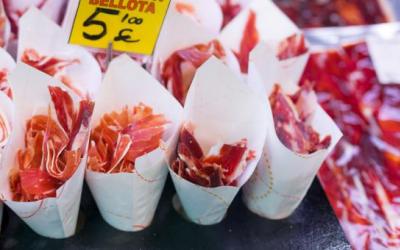On the importance of controlling quarantine weeds

Quarantine weeds are a separate group of plants that can cause enormous damage to agriculture. Quarantine weeds include: tripartite ragweed Ambrosia trifida L., perennial ragweed Ambrosia psilostachya DC., ragwort Ambrosia artemisiifolia L., creeping bitterweed Acroptilon repens DC., prickly nightshade Solanum rostratum Dun., triflorous nightshade Solanum triflorum Nutt., dodder Cuscuta spp., Cenchrus longispinus (Hack) Fern) and other weeds included in the Unified List of Quarantine Objects of the Eurasian Economic Union.
On the territory of the Penza region, tripartite ragweed, wormwood ragweed and dodder are common.
The harmfulness of ragweed is determined by the high allergenicity of the pollen, released in huge quantities. Its pollen causes a disease - ragweed hay fever, which negatively affects the ecological situation in regions where ragweed is widespread. Moreover, its flowering period is significant - from June to September. Children especially suffer . Allergies from it can even turn into asthma.
Ambrosia, developing a powerful above-ground mass and root system, greatly suppresses cultivated plants. It consumes a lot of water to form a unit of dry matter (on average 2 times more than cereal grains), which leads to drying out of the soil. Ambrosia sharply reduces soil fertility, removing large amounts of plant mineral nutrients from it. The crops most often affected by ragweed are cereal grains, legumes, buckwheat and row crops, especially sunflower. With insufficient care for the crops of these crops, ragweed outgrows them and severely choke them, which leads to a sharp decrease or complete loss of the crop . Cattle do not eat ragweed because of the bitter essential oils contained in its leaves, so the quality of green fodder and hay contaminated with ragweed deteriorates.
Экономический ущерб от повилики в районах массового ее распространения исключительно велик. Он складывается из нескольких составляющих: снижения урожайности сельскохозяйственных культур; засорения получаемого урожая; ухудшения качества кормов и снижения продуктивности пастбищ; расходов на очистку семян, агротехнические мероприятия и гербициды. Опасна повилика не только флоре, но и фауне, т.к. содержит ядовитые алкалоиды. Они вызывают серьезное отравление у животных, съевших сухой сорняк вместе с сеном. Повилики являются переносчиками возбудителей ряда вирусных заболеваний растений. Вирусы сохраняются в растениях повилики от нескольких дней до 4 месяцев и более.
Борьба с карантинными растениями должна проводиться своевременно и в полном объеме.
Methods of combating quarantine weeds include agrotechnical measures of a preventive nature, as well as treating contaminated fields with herbicides in accordance with the “State Catalog of Pesticides and Agrochemicals Permitted for Use on the Territory of the Russian Federation.”
Methods of controlling quarantine weeds:
- mowing roadsides and vacant lots until seeds appear on plants;
- use of proven seed material;
- timely and thorough soil treatment - pre-sowing cultivation, pre-emergence and post-emergence harrowing;
- compliance with crop rotation, in order to improve the HEALTH of the soil and treat it from harmful plants, leave clean fallows;
- treatment with herbicides.
Source: Press service of the ROSSELKHOZNADZOR Office for the Republic of Mordovia and the Penza Region
Read together with it:
- He crawled to the icon with prayer. The true story of a man who overcame drug addiction.Alexander Ovchinnikov. Topic News. Our project's hero was a drug addict for many years. The thought that this was a dead end never left him, but his addiction proved stronger. One day, when he could no longer walk, he crawled to an icon in prayer. This became his first step toward a new life. Today, he heads a charity center that helps those who have given up hope and are unable to quit ALCOHOL an...
- Лучшие не только по молоку. Какие рекорды поставили в экспериментальной базе имени КотовскогоНовости темы Экспериментальная база имени Котовского известна далеко за пределами Узденщины благодаря высоким показателям, которых из года в год добиваются в хозяйстве. Лучшие результаты в районе агропредприятие показывает как по молоку и зерновым, так и по сахарной свекле. Страда этого года, проходившая не в самых простых погодных условиях, также стала рекордной. Хлеб – всему голова Весна 2.........
- How will the ban on multiple-entry Schengen visas affect travel to the EU?The European Commission has limited the issuance of new multiple-entry visas to Russian citizens, requiring them to apply for each planned trip. How will travel patterns change, and will Russians travel to Europe less?On Friday, November 7, the European Commission (EC) announced its decision to restrict the issuance of multiple-entry Schengen visas to European Union countries to Russian citizens. ...
- "Вода лечит, дает силы". Этот белорус строит уникальные лодкиНовости темы Душа этого полешука знает тайны водных просторов Ясельды, на берегу которой он родился и рос, Мотольского, Споровского и других озер в агрородке Мотоль, что на Брестчине. Сегодня практически один в Беларуси создает такие деревянные лодки, которые просто летят по водной глади. Потому и пользуются огромной популярностью у земляков и не только. Мы побывали в гостях у Пал Палыча, которому...




























































